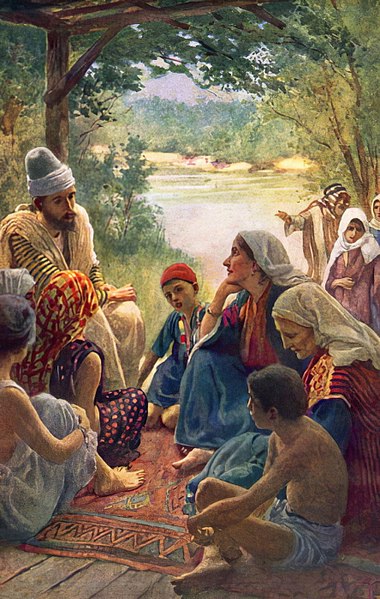Women Witnesses
The feast of Ss. Dorcas, Lydia, and Phoebe is worth the attention of Christians not only because it commemorates three notable women of the New Testament, mentioned in Acts or St. Paul‘s letters, but also because it recognizes the contributions that women made to the early life of the Church. These few women represent the many who functioned as deaconesses within the church, were financiers of ministry, Christian leaders, and servants to their neighbors.
St. Dorcas

Dorcas, or Tabitha (meaning “gazelle”), was a woman from Joppa, a seacoast town in Israel, who became a follower of St. Peter. Noted for her acts of charity, she was known for making and giving garments to the needy widows of the Church. When she died, the members of her community asked Peter to come. When he arrived, Dorcas had been laid out, and he “knelt down and prayed; and turning to the body he said, ‘Tabitha arise’” (Acts 9:40). She was miraculously restored to life—an act considered the first miracle performed by one of the apostles. Scripture tells us that it caused many to believe in the Lord (Acts 9:43).
St. Lydia

The second saint of the day, Lydia, was the Apostle Paul‘s first convert to faith. A native of Thyatira in Asia Minor, she lived in Philippi in Macedonia. It was there that she was a merchant of purple-red dyed goods, known as Tyrian purple, highly prized throughout antiquity. Wearing this color was a mark of high status, and for this reason, Lydia is considered to have come from considerable wealth.
When St. Paul first met her outside Philippi, she was praying on the Sabbath even though she was a Gentile. According to Acts, “the Lord opened her heart to pay attention” to Paul’s preaching, and she and her household were eventually baptized. Going forward, she asked Paul, Luke, and their companions to stay at her house and make her house their headquarters in Philippi so that she could support their evangelizing work.
This was surely a great gift to Paul as it was his custom elsewhere to work to earn money to pay for his living expenses. Through his letter to the church at Philippi, we see that Paul had a special love for that congregation; Lydia’s help and support for him was surely part of this strong relationship.
St. Phoebe

Finally, Phoebe (meaning “bright” or “radiant”) was a deaconess within the church at Cenchreae, an eastern seaport of Corinth. When we first find Phoebe mentioned in Romans, however, St. Paul told the church in Rome that they should take her in and “welcome her in the Lord in a way worthy of the saints, and help her in whatever she may need from you, for she has been a patron of many, and of myself as well” (Romans 16:1-2). While we don’t know much about the exact characteristics of Phoebe’s work, we know that it was significant to the early Church and a great assistance to the men in the ministry.
A Brief History
Together, these three saints comprise three of the most notable women from the earliest days of the Church. They are remembered, even today, for their good works, support of the Church, and service to God. Their day, October 25th, marks these women’s stories and encourages the Church to continue to remember them and their gifts to all of Christendom.
Some of the ways in which these women still influence the fabric of our churches’ life together are particularly notable for Lutherans and other Christians alike. For one, Dorcas is still linked today to Dorcas Societies, which provide clothing and other material needs to the poor. The original society, founded in 1834, was established in thanksgiving for her, and the entities have since supported many philanthropic issues.
Lydia has always been remembered for being St. Paul‘s first convert to faith and for giving financial support to the Church. This role acknowledges the importance of women who are not just tied to households but rather have the ability to support themselves independently, women who can use their means to support the Church. Others include Martha of Bethany (Luke 10:38), Mary of Jerusalem (Acts 12:12), Chloe of Corinth (1 Corinthians 1:11), Nympha of Laodicea (Colossians 4:15), as well as Mary Magdalene, Joanna, Susanna, and others who the Bible tells us accompanied Jesus and the disciples and ministered to them from their own finances.
Finally, Phoebe has been linked to the office of deaconess, a position that has been a feature of some parts of American Lutheranism since the days of Wilhelm Löhe, a nineteenth-century German pastor who supported the training of deaconesses and had a great influence on his American countrymen. As their name would suggest, these women devote themselves to acts of service performed within and on behalf of the Church, and consequently they have often looked to Phoebe as a biblical example of a woman who devoted her abilities to Christian service.
Collect
Hear us, O God, our Savior: so that we, who rejoice in the feast of Blessed Dorcas, Lydia, and Phoebe, may learn from them the spirit of loving devotion; through Jesus Christ, Thy Son, our Lord, who liveth and reigneth with Thee and the Holy Ghost: ever one God, world without end. Amen.
Lessons
Resources
Issues, Etc. interview with the Rev. Dr. Michael Middendorf on Lydia, Dorcas, and Phoebe
Issues, Etc. interview with the Rev. Dr. Robert Sorensen on Dorcas, Lydia, and Phoebe
Propers found in Daily Divine Service Book: A Lutheran Daily Missal, edited by the Rev. Heath Curtis
References:
1. Weedon, William. Celebrating the Saints. Concordia Publishing House. 2016.
Images:
1. Fabrizio Santafede, Saint Peter raises Tabitha, Italy, 1611.
2. Harold Copping, Lydia of Thyatira, England, ca. 19th century.
3. Unknown.
Some links might be affiliate links which means we may receive a small commission at no extra cost to you. As an Amazon Associate we earn from qualifying purchases.



